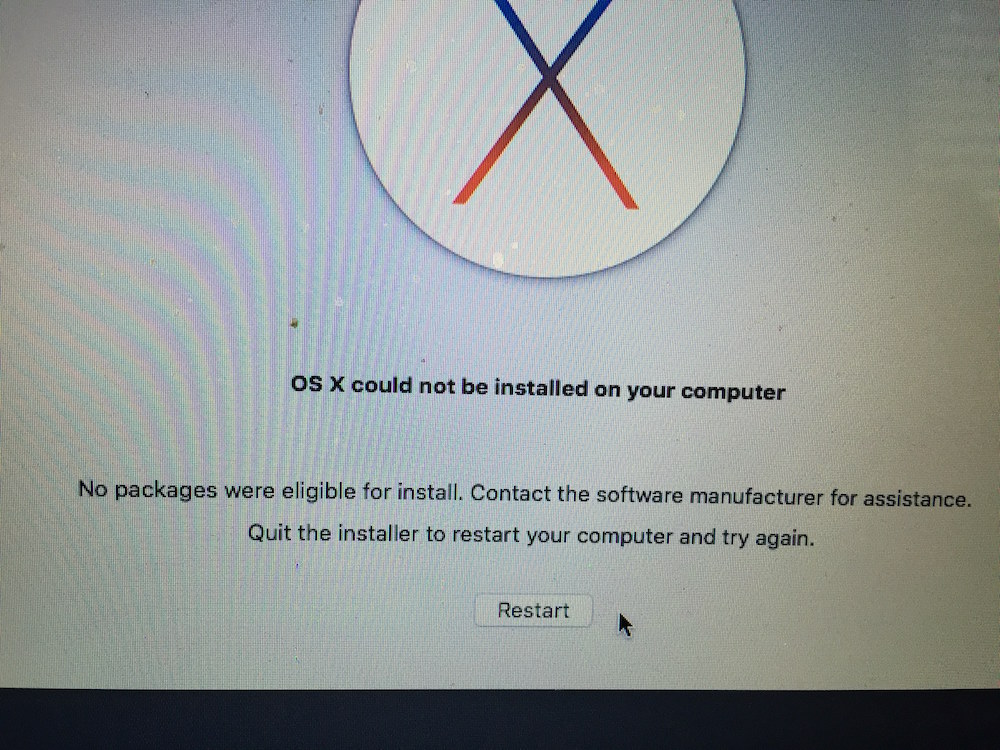No Packages Were Eligible For Install Os X
OS X could not be installed on your computer.
No packages were eligible for install. Contact the software manufacturer for assistance.
Quit the installer to restart your computer and try again
Oh dear… When trying to install OS X 10.11 (El Capitan) you may encounter this message. This happens because the the installer certificates are no longer valid when checked against the clock of your mac.
By default, the Mac OS X installer will not work with hard drives that were originally formatted in Windows. Therefore, if your computer’s hard drive already has Windows installed on it, you won’t be able to install Mac OS X on there. Feb 15, 2016 This went absolutely fine and I now have a fully indepentent USB Drive which i can simple connect to the PC and the El Captain OS boots up. Case 2: I next tried to use the same bootable USB to install El Capatin on a SATA Drive. I had formated the drive for OS X Extended (Journaled) with Guided Partition Table.
- If your macOS Sierra won't install or you face the same problem with other versions, then don't worry. In this guide, we will teach what to do when macOS could not be installed on your computer. Restart and Reinstall Mac. Check Mac Date & Time. Free Up Mac Space.
- When reinstalling OS X on a Mac Computer running into this issue can be very frustrating. There is a pretty simple way to solve it but it's quite hard to kno.
- Check that your Mac’s Date&Time are on Set Automatically. Reset your Mac’s NVRAM or PRAM. Free up some internal hard drive storage. Restart in Safe Mode and run Disk Utility’s First Aid. Try Recovery Mode. Use Terminal to identify and remove non-Apple KEXTs. Restart in Single User Mode to remove problematic files.
Don’t panic though as this is easily fixed using Terminal, so don’t restart immediately.
- Click Utilities on the menu bar
- Select Terminal
- Type date 062112422016
- Exit Terminal
- Click Restart
When you restart the mac and try the installer again it will now believe the certificates are valid and will continue as it should.
; Date: Sun Oct 16 2016Tags: Mac OS X
A key step for upgrading the disk on a MacBook Pro is to install a new operating system on the new drive, and then use Migration Assistant to copy over the old data. Depending on how you went about the work, installing Mac OS X on the new system may give you a message: OS X could not be installed on your computer. No packages were eligible for install.
This is what it looks like in the installer. Upon seeing this I went 'HUH?' because the installation was from a thumb drive I'd used many times to install Mac OS X (El Capitan) successfully.
The above image came from an attempt to install El Capitan. I just got the following message, macOS could not be installed on your computer, while trying to install macOS High Sierra.
In both cases there was the same cause. In the El Capitan case, as I say in the next paragraph, the hardware clock had reset to zero because it did not have a battery pack. In the High Sierra case, I had performed a hardware reset of the computer in an attempt to fix a bootup problem. I had found advice to disconnect the battery, the power supply, then hold down the power key for a few moments. In both cases the hardware clock had been reset to zero, and macOS refused to boot.
After some yahoogling (duckduckgoing) I came across a simple solution. This particular computer had been running with no battery, and therefore the hardware clock was reset to zero, and Mac OS X had a test against that condition.

We've discussed elsewhere the process to install Mac OS X onto a computer, and transfer information from an old drive. It's during that process when the above message appears. A couple steps prior is where you can take action to correct the problem.
At this step, click on Terminal ...
Then change the operating system date.
No Packages Were Eligible For Install Os X 2017
When running this particular Terminal session, you are ROOT meaning you can change anything on the computer. Normally we type 'date' at the command line just to find out the current day/month/year/time. But, the date command can be used to change the time registered in the system clock.
As I said above, for this particular computer the system clock had been reset to zero because the battery pack had been changed. In fact, the computer had run without a battery for many months because the old battery had gone bad.
As you see on the screen, the date had been January 1, 2001. I then changed the system date to the current time as of the writing of this posting.
To understand the second command, go to a terminal window and type 'man date'.
In the synopsis section you'll see this as an option for the 'date' command:
That's a little obtuse, but further down the manpage is this key:
In other words, the date code for this purpose is month-day-hour-minutes-year ... hence, that's what I entered and it changed the system date to match.
No Packages Were Eligible For Install Os X 10 11
Afterward I closed the Terminal window and was able to successfully install Mac OS X on the computer.